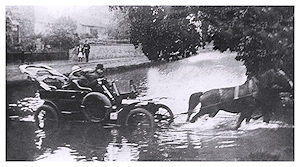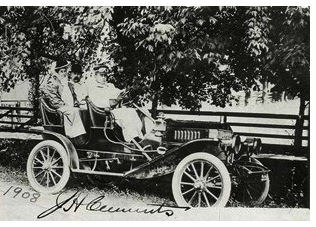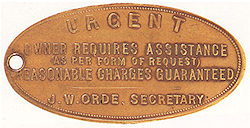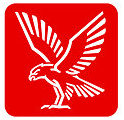A History of Vehicle Recovery Part1

Vehicle recovery is as old as the car itself although a recovery back then, was most likely to have been done with the aid of a
horse. Many of the first garages and automobile coachworks, emerged from the blacksmith’s and bicycle trades and automatically took to
recovering their customer disabled vehicles. What many people may not appreciate however, is that the expression 'Recovery' only
started to be used generally just prior to the second world war. Initially the more common term was 'To Salvage', no doubt linked to
maritime practises of the time. Salvaging was very common, because vehicles were very unreliable. Races like the legendary Mille Miglia
were organised not for speed, but to test a car's endurance, with most not making the 1000 miles. The Brooklands track
was initially proposed by Locke King, as a car endurance testing circuit and was often used for that, throughout its
life

The most common reason for needing some form of recovery was after something ‘failing’ on the vehicle and in most cases a simple tow rope could be used to get the casualty to a place of repair. Where the specialist equipment we now expect recovery vehicles to have as standard is needed, was because of the vehicle being unable to roll and the most common cause of this was after an accident of some sort.
What is generally accepted as the first petrol powered vehicle accident happened to a distant relative of the webmaster John Lambert of the Lambert of The Lambert Automobile Company (shown in the picture in a Lambert car). The incident happened in 1891 when he crashed his vehicle after hitting a tree root, causing the car to go out of control and smash into a fence. Fortunately his Injuries were minor and he went on to build a very successful manufacturing company and patented over six hundred inventions, mostly affiliated with the automobile industry.
Most motorists were enthusiast and so would often rely on their own ingenuity, to 'get back on the road'. Failing that, they would seek help from any passing motorist, or lastly call on a local garage. Small local 'private' Car Clubs sprung up and some kept a ‘cash kitty’ to assist their stranded members, but that was about as organised as it got for the poor motorist. As the twentieth century got underway however, two motoring clubs would become large enough to have nationwide membership. These were of course The Automobile Association formed in 1905) and The Royal Automobile Club (formed in 1897 and named royal in 1907).
Both organisations were initially set up to help motorists to obtain fair treatment from the authorities. Although the organisations become more 'service' related as the years went by, both later also diversified into several non motoring areas (with varying success). The services they offered then however, bears little relationship to those offered by today's clubs. Both organisations would try to repair members vehicles, with the limited tools and parts their vehicle carried. Spares could often be collected from the many local garages and the nature of the vehicles was such that a block of wood, some clean dry cloth, a roll of insulating tape, a length of wire and piece of rope could fix almost any fault. Communications were often difficult as it was not until the fifties that these 'patrol vehicles' would be linked to their control by radio. The AA going live in 1950 and the RAC in 1958. Consequently patrols had to go to their box at prearranged times, to be allocated jobs. If a 'tow' was required because a repair was not viable, he would have to return to his box to arrange a local garage and the member would have to pay the garage for the recovery.
 The first club to offer any form of limited 'Get you home service' was the RAC, in 1912. Members could apply for a brass token,
which when handed to a RAC Appointed Garage, would "Bring the necessary assistance and will indemnify you as the owner of the disc,
against the cost of hiring another car to get you and your party home". The instructions for the use of the token, also make
interesting reading:- "On the occurrence of a breakdown you send this Talisman by an RAC Touring Guide (patrol), or by the first
available messenger (clearly no mobile phone's then), to the nearest RAC repairer. Who will at once send a relief car to convey you and
your party home" (note the 'at once'!) The restrictions on its use were probably acceptable for the average private motorist at that
time. For example it was only valid up to 20 miles from your home and it did not cover accidents. If however you were less than 10
miles from your home, then you could also have the car towed there using the Talisman. By the late twenties the RAC were dealing with
in excess of 10,000 claims a year. Incidents of accidents or breakdowns, were high for the number of vehicles on the road, but were
still uncommon occurrences, due to the small number of vehicles and the short distances they travelled.
The first club to offer any form of limited 'Get you home service' was the RAC, in 1912. Members could apply for a brass token,
which when handed to a RAC Appointed Garage, would "Bring the necessary assistance and will indemnify you as the owner of the disc,
against the cost of hiring another car to get you and your party home". The instructions for the use of the token, also make
interesting reading:- "On the occurrence of a breakdown you send this Talisman by an RAC Touring Guide (patrol), or by the first
available messenger (clearly no mobile phone's then), to the nearest RAC repairer. Who will at once send a relief car to convey you and
your party home" (note the 'at once'!) The restrictions on its use were probably acceptable for the average private motorist at that
time. For example it was only valid up to 20 miles from your home and it did not cover accidents. If however you were less than 10
miles from your home, then you could also have the car towed there using the Talisman. By the late twenties the RAC were dealing with
in excess of 10,000 claims a year. Incidents of accidents or breakdowns, were high for the number of vehicles on the road, but were
still uncommon occurrences, due to the small number of vehicles and the short distances they travelled.
The Change Begins
The roots of today’s recovery industry can be traced back to the late sixties. In some areas it was not Garages that operated small fleets of recovery vehicles, but coachworks. The reason was simple, they needed to find work! This was often achieved by monitoring the police radio network, listening for accident reports. Once the location was heard, it would be a race to be the first vehicle on the scene. However, the majority of breakdown vehicles were operated by small garages. to start with, just to deal with their customer’s needs when they broke down. As the work increased however, often one of the mechanics would tend to get nominated to do the breakdowns, mainly because he could handle the often unsociable hours. Very often also, that mechanic was the governor himself, or his son. There soon developed a certain camaraderie between the recovery vehicle drivers themselves and later the companies. For the first time operatives started to became Drivers (rather than Mechanics that also did breakdowns). Most were self employed and stayed out of the workshop.
Some of the Garages (including some of the long established ones),were also starting to view breakdown recovery as something very different from their normal work. Accident recovery had always required special skills, but as vehicles got faster and more fragile (Chassis became integral to the body), recovery become more difficult. This was especially true for commercial vehicles, which not only had got heavier, but had started to become more sophisticated. Many garages were agents for the two ‘clubs’ (AA and RAC), but for most the majority of their work still came from their own customers and people who found them in the phone book. Some garages also started to use the services of local ‘recovery only’ companies (usually owner drivers) and found it was cheaper than doing it themselves.
Then in 1969 Dennis Thrustle launched ‘Car Recovery Club’ in Hull. By any standards it was small, with just a few hundred local members and to start with, the cover cost just ten bob! (or in today's money 50p). It did however gave other people ideas and within a short while, the number of 'so called' breakdown clubs reached around 40 organisations nationwide. These early clubs, only provided recovery after a major breakdown and in some cases after an accident, Recovery was only back to the members home area (home, or his local garage). Often this meant a recovery vehicle went out to collect the vehicle, from the clubs control room. or workshop, which could add to the journey time. Clearly there was a need for recovery "clubs" to become national and accept members from anywhere on the British Mainland. This meant that 'sub-contract' garages were contacted close to the point of breakdown, speeding up collection time. Often recoveries involved driver and passengers as well as the vehicle and so garages with recovery vehicles that could carry more than 2 passengers (still a novelty then) were especially looked for.
 During 1970, Robert (Bob)
Slicer, along with Jeffery Pittock formed National Breakdown Recovery Club, operating out of
a Fish and Chip shop in Bradford owned by Bob's family. They were soon also joined by Ernest Smith, largely because of
his experience in transporting vintage vehicles. Initially the service only covered their member for a 50 mile radius around Bradford,
but this soon become nationwide. This was achieved by recruiting recovery operators, to work as their agents. These agents were
selected from the best recovery operators and garages. Inspections of the equipment and facilities was regularly carried out, by NBRC's
base inspectors. The now very rare reflective stick-on logo pictured on the right, soon became a symbol of pride to many a recovery
operator. One of the key differences to the schemes operated by The RAC and The AA, was that NBRC members, were not covered for
repairable breakdowns, but if your vehicle could not be fixed, you would be recovered home for free. NBRC also covered you if you had
an RTA (Road Traffic Accident), something virtually unheard of at the time.
During 1970, Robert (Bob)
Slicer, along with Jeffery Pittock formed National Breakdown Recovery Club, operating out of
a Fish and Chip shop in Bradford owned by Bob's family. They were soon also joined by Ernest Smith, largely because of
his experience in transporting vintage vehicles. Initially the service only covered their member for a 50 mile radius around Bradford,
but this soon become nationwide. This was achieved by recruiting recovery operators, to work as their agents. These agents were
selected from the best recovery operators and garages. Inspections of the equipment and facilities was regularly carried out, by NBRC's
base inspectors. The now very rare reflective stick-on logo pictured on the right, soon became a symbol of pride to many a recovery
operator. One of the key differences to the schemes operated by The RAC and The AA, was that NBRC members, were not covered for
repairable breakdowns, but if your vehicle could not be fixed, you would be recovered home for free. NBRC also covered you if you had
an RTA (Road Traffic Accident), something virtually unheard of at the time.
 Although NBRC are remembered as the people who ‘got it right’ in the United Kingdom, mention must also be made
of Maurice Clarke’s Red Rover Recovery Club of Rugby, another visionary company, albeit one with a chequered and at
times complicated existence! Among Red Rovers developments was a 90 minute guarantee, refunding a members annual fee if it took longer
than 90 Mins to reach a stranded member. Only on odd occasions did their recovery network fail to achieve their aim, and no member ever
claimed under the guarantee. Formed in 1972 Red Rovers had some considerable success to start with, but it suffered from lack of
funding and eventually failed. It was re launched as Red Rovers Motorists Association in 1984 but sadly collapsed again (In a interview
published in Vehicle Recovery in the spring of 1986 Maurice blamed the failure on him using Red Rovers money to try and save
Car Recovery Service Club of London, which it had undertaken jointly with Autohome of Northampton.
Later the Red Rovers Membership was acquired by Autohome
Although NBRC are remembered as the people who ‘got it right’ in the United Kingdom, mention must also be made
of Maurice Clarke’s Red Rover Recovery Club of Rugby, another visionary company, albeit one with a chequered and at
times complicated existence! Among Red Rovers developments was a 90 minute guarantee, refunding a members annual fee if it took longer
than 90 Mins to reach a stranded member. Only on odd occasions did their recovery network fail to achieve their aim, and no member ever
claimed under the guarantee. Formed in 1972 Red Rovers had some considerable success to start with, but it suffered from lack of
funding and eventually failed. It was re launched as Red Rovers Motorists Association in 1984 but sadly collapsed again (In a interview
published in Vehicle Recovery in the spring of 1986 Maurice blamed the failure on him using Red Rovers money to try and save
Car Recovery Service Club of London, which it had undertaken jointly with Autohome of Northampton.
Later the Red Rovers Membership was acquired by Autohome
In the seventies the Department of Trade and Industry (DTI) started to take an interest in these new organisations and deemed them to be insurance contracts. As such they required them to be underwritten by an existing insurance company or become registered as their own Insurance Company under special financial conditions. One organisation Autohome Insurance Ltd of Northampton took this latter route, other closed down, and a few were able to secure insurance underwriting. This led membership fees to rise to cover the extra costs, but it also provided greater protection for members. The DTI's view was taken by comparing recovery clubs to insurance with an (uncontested) High Court legal case - Department of Trade and Industry v St Christopher Motorists' Association Ltd [1974]. No case was ever brought against a recovery organisation to prove this point, clearly heavy legal costs and potential negative publicity inhibited organisations from trying to argue the case. One underwriter Equity Motor Policies at Lloyds who briefly underwrote the Red Rovers scheme started its own recovery organisation which still operates (as off today 2016) Autonational Recovery
 At this point a brief mention should also be made of
events in Northern Europe. In 1906 Sophus Falck had started Falcks Redningskorps (Falck Rescue) in
Denmark. Sophus did not initially see it as a profit making business, offering instead to "Act when People or Animals are in Danger of
Life. To help no matter if payment is possible or not". Before long Falck had established both fire and ambulance services, to
complement the roadside rescue. Then in the late forties a Norwegian called Arne Andresen, spent some time in Denmark
studying Falck's methods. He returned to Norway and with the Falcks family's full blessing, set up Falken
Redningskorps. Initially this only offered roadside assistance, but like its sister company in Denmark, it also expanded in to
ambulance services and other support / security industries. However, the Norwegian auto repair garage's own association AVL saw this as
a threat to their livelihood and in turn set up a rival organisation called Viking Redningstjeneste during 1956. The
two organisations sadly would become bitter rivals.
At this point a brief mention should also be made of
events in Northern Europe. In 1906 Sophus Falck had started Falcks Redningskorps (Falck Rescue) in
Denmark. Sophus did not initially see it as a profit making business, offering instead to "Act when People or Animals are in Danger of
Life. To help no matter if payment is possible or not". Before long Falck had established both fire and ambulance services, to
complement the roadside rescue. Then in the late forties a Norwegian called Arne Andresen, spent some time in Denmark
studying Falck's methods. He returned to Norway and with the Falcks family's full blessing, set up Falken
Redningskorps. Initially this only offered roadside assistance, but like its sister company in Denmark, it also expanded in to
ambulance services and other support / security industries. However, the Norwegian auto repair garage's own association AVL saw this as
a threat to their livelihood and in turn set up a rival organisation called Viking Redningstjeneste during 1956. The
two organisations sadly would become bitter rivals.
The ‘Big Two’ respond
It was a couple of years, before the ‘big two’ clubs started to react to what was happening in the industry. The AA being first to respond, when on the 1st of October 1973 they launched their ‘Relay’ Service. This was sold as an addition to the standard breakdown cover. The AA's fleet of some 150 Relay vehicles was made up largely of Bedford J3s, as shown below. They also started to use approved garages with suitable vehicles, when their own relay fleet was overloaded.

Then in 1975 The RAC responded with their own service aptly named "Recovery". Both were advertised as ‘transportation of member and vehicle after a major breakdown, to any destination on the UK mainland’ services. The RAC however, also included cover for ‘recovery after an accident’. Eric Charles (head of RAC Motoring Services), purchased a number of Range Rovers and trailers and had them liveried in RAC colours. This was to create the impressions that this new 'get you home' Recovery service, was being carried out by the RAC themselves. The truth then (as it is today), is that most RAC recoveries were carried out by carefully selected RAC agent, leaving the main RAC fleet concentrating on covering breakdowns. In the case of the AA they have always largely carried out there own recoveries, but again will use their agents at peak times
National Breakdown did not sit back of course, they continued to grow and the decision was taken to move out of their by now famous (in the industry) Low Moor Head Quarters. On the 27th July 1989 no lesser person that HRH Diana Princess of Wales, opened their new building in Leeds. One can only guess what was going through Bob Slicer's mind, but perhaps he thought back to his Fish and Chip shop, where the business had started some twenty years earlier.

NBRC are remembered as the 'trend setters' from those early days, but they were not alone. Other names (many of them now gone) were: Autohome (the only recovery "insurance company" and who took over Red Rovers), B.A.S Car Recovery Club, Car Recovery Club (Eagle) of London. Good Samaritans, Knights of the Road, Red Rovers and UK Recovery. All of them dealing with cars and light vans, there were also a number dealing with commercial vehicles which we will look at later. The name National Breakdown Recovery Club would also eventually disappear, when it changed its name to Green Flag in 1994. This came about because the company wanted to branch out into other, areas like medical assistance The board thought they could see negative connotations by the use of the word "breakdown" and so settled on Green Flag, because they said "it translates well abroad, green being a symbol of health in Europe". Then NBRC / Green Flag was acquired by National Car Parks, until NCP were purchase by Cinven, who then sold it to Direct Line in 1999. Green Flag became a major sponsor of the England national football team for the first time in 1994. The initial sponsorship deal was worth £4 million over a four-season period ending with the World Cup final tournament in July,1998. It was this sponsorship that brought the name to many potential new members. They also sponsored the British Touring Car Championship between 2002 and 2004.
Footnote to the above In 2011 Direct Line's parent company RBS (Royal Bank of Scotland) decided to take a more 'branded' approach to recovery and at very short notice did not renew the contracts of many of its agents, deciding instead to operate in England 'Super Agents' using liveried recovery vehicles. The direct result was that many good recovery business that relied on that work failed and others suffered hard times for many years after. Many of us involved in Vehicle Recovery were relieved that both Bob Slicer and Ernest Smith two gentlemen of the industry, did not live long enough to have seen this act of betrayal. Bob had died in Australia during June 2010 and Ernest in London during October 2001.
A popular and flexible alternative to belonging to a recovery organisation, was launched 1978 by The Guild of Experienced Motorists (previously the Company of Veteran Motorists). It was called GEM Recovery and it was a 'pay and claim' service. In the event of you needing a recovery, you arranged it with a local garage, paid yourself and sent the invoice to GEM for a refund. In later years GEM would also offer their own recovery package and in January 2004 became GEM Motoring Assist.
With all these clubs encouraging motorist to take out membership and then (in the main) passing the work out to the trade, the recovery industry started to grow. Most of the work was still being undertaken by the "traditional garages" and the "coachworks repairers" looking for extra work, but the 'specialist' recovery operators were beginning to surface, as an 'industry' of their own. In the next section we will look at the growth of Recovery Operators.

